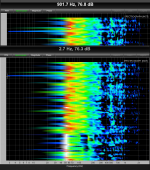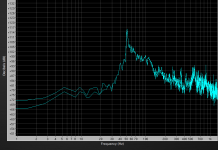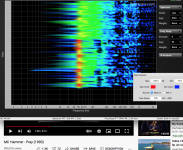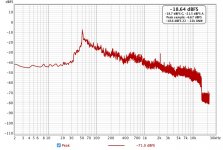Back in 1990, bass sounds like that could be created on a variety of analog synthesizers (Oberheim, Moog etc.), or samples of them played (or programmed) on digital sampling keyboards , or possibly truncated samples of the classic analog Roland 808 that was/is popular in that genre:
FREE 808 Bass - 100 Key-Labeled 808 Bass Samples - Huge Low End
"Pray" also uses a sample from Prince's "When Doves Cry" over and over.
Art
FREE 808 Bass - 100 Key-Labeled 808 Bass Samples - Huge Low End
"Pray" also uses a sample from Prince's "When Doves Cry" over and over.
Art
Last edited:
It didn't sound like conventional use of an 808. I was perhaps confused because it is the most tuneless bass I've heard outside of movie special effects.
The "When Doves Cry" thing is common knowledge. It's what MC Hammer does. "U Can't Touch This" used so much of Rick James' "SuperFreak" that Hammer was forced to list James as a co-writer.
The "When Doves Cry" thing is common knowledge. It's what MC Hammer does. "U Can't Touch This" used so much of Rick James' "SuperFreak" that Hammer was forced to list James as a co-writer.
My guess is one of the Alesis classic drum machines. Not many had the same dry snappy warm sound. Part of the trick is using short ADSR setting and reverb to control the length
/release hence almost like a pink noise tail and not a specific frequency. Google it. Tons of 90s pop used it. Almost as important as 909/808 was to dance and hip hop was the alesis to pop.
/release hence almost like a pink noise tail and not a specific frequency. Google it. Tons of 90s pop used it. Almost as important as 909/808 was to dance and hip hop was the alesis to pop.
Last edited:
"the average house or car stereo in 1990 the bassline was probably inaudible to most"
Surtsey - what are you figuring is the baseline frequency?
Anybody want to offer a Hz figure?
B.
The fundamental note(s) are probably in the 35-40Hz range. However, because it is not a natural sound there are almost no overtones. If you play an E on a bass guitar you will get fundamental frequency of 41Hz, in addition you will hear overtones all the way up the scale. Hence, if you play a bass guitar the notes will still be represented in a tweeter. This sound is similar to a
Last edited:
My guess is one of the Alesis classic drum machines. Not many had the same dry snappy warm sound. Part of the trick is using short ADSR setting and reverb to control the length
/release hence almost like a pink noise tail and not a specific frequency. Google it. Tons of 90s pop used it. Almost as important as 909/808 was to dance and hip hop was the alesis to pop.
You are saying a broad bump in the bass, not tooooo peaked? But what is your estimate of the central frequency?
B.
I may have misunderstood. Are you talking about the kick drum or the synth baseline? I believe the kick drum is the Alesis with no particular frequency tone. The baseline however vary with the notes played. The synth bass sound itself sounds like any 80s analog subtractive mono synth, like was mentioned Moog or Korg. Frequency is determined by finding the notes of the baseline or by using a frequency spectrum analyzer. Too much work for me, I’m sorry.
You are saying that repeated drum-like sound has no particular frequency? Hmmm.
I am just asking if anybody will say what that repeated "boom... boom... boom..." in the Pray piece's frequency is?
The subwoofer forum is premised on folks wanting their subs to reach down to a certain target range or band, say 20 Hz, just to name the conventional meme. So here's an example of a repeated sound.
What do people think is that frequency? Is that your target?
It seems there aren't many forum members willing - so far - to show the goodness or badness of their ability to know what the heck is being played.
B.
I am just asking if anybody will say what that repeated "boom... boom... boom..." in the Pray piece's frequency is?
The subwoofer forum is premised on folks wanting their subs to reach down to a certain target range or band, say 20 Hz, just to name the conventional meme. So here's an example of a repeated sound.
What do people think is that frequency? Is that your target?
It seems there aren't many forum members willing - so far - to show the goodness or badness of their ability to know what the heck is being played.
B.
DOWNLOAD >> DRUMS (FULL KITS)/DRUM MACHINES/Alesis HR16/ (Free sounds, samples, loops)
Check samples bass 01-06, are these similar to what you are looking for when you say boom? We usually call them kicks not bass.
I doubt any of these samples go down to 20hz though.
The volume of energy is probably 50-200hz and then overtones to make it snappy.
You can analyze the wave with software.
Check samples bass 01-06, are these similar to what you are looking for when you say boom? We usually call them kicks not bass.
I doubt any of these samples go down to 20hz though.
The volume of energy is probably 50-200hz and then overtones to make it snappy.
You can analyze the wave with software.
Last edited:
Surtsey,Fabrica, we are not discussing kicks. There is what sounds like a single, repeated bass note around 35hz-40hz. There may be lower notes but my system doesn't go below 35Hz.
Whether the synthetic droning samples are called “kicks” or “baseline” is really just semantics. The line between the two was blurred decades before “Pray” was created, when various attack/decay envelopes and low frequency oscillators began being used to modify various combinations of waveforms to sound like acoustic instruments, or something quite different.
There are many different, repeated bass notes and glissando samples with fundamentals well below 35Hz in the song.
I’ve posted screen prints of spectrographs (and an RTA with a 3-second "peak hold") of some portions of the song below. The music progresses vertically, most recent being at the bottom of the graph, amplitude displayed in color red being loudest, fading to yellow, green, then blue 25dB below the red level. When the music is stopped, the spectrograph goes black, indicating what is on screen is “music”, not noise.
Whatever you want to call them, the loudest sustained notes in “Pray” are in the octave from 35-70 Hz. Though the average level generally drops off steeply below 35 Hz, there are some glissandos tones with content even below 2Hz, an example below shows one of those with level at 2.7Hz equal in amplitude to the spectrum at 900Hz.
Whether your system can reproduce those frequencies adequately to hear or feel them, they are there in the recording. Boost the lower range with EQ enough and drive your speakers with enough level to exceed Xmax, and you’ll hear the harmonics of them ;^).
That said, having listened to “Pray” on headphones and hearing most of it’s ELF junk, I’d prefer a 35Hz BW24HP on the mix to get rid of it.
Attachments
Last edited:
OK, David Morison deserves the Brave Person award. Also Perceptive/Correct Person special recognition award.IMO the prominent stuff is about 50-odd Hz, not really deep by today's standards.
There might be a little bit of content below that but nowhere near as loud.
The dull repeated note is pure 51 Hz and there's not much below, as Art posted previously. This kind of booom-booom shown in the RTA below (all the peaks in the entire Pray clip) is typical of pop music and is routinely mistaken for low bass. Actually, the folks playing loud music in cars might be getting their bass thrills from 80 Hz, not 51.
Self-aggrandizing Golden Ears may not have a clue how lousy (almost) all of us are trying to be analytic about sound, mistaking treble boost for bass cut and vice versa. And you can see how few DIYaudio members were willing to stick their necks out with a guess (prolly smart on their part).
B.
Attachments
Last edited:
....Though the average level generally drops off steeply below 35 Hz, there are some glissandos tones with content even below 2Hz, an example below shows one of those with level at 2.7Hz equal in amplitude to the spectrum at 900Hz.
Whether your system can reproduce those frequencies adequately to hear or feel them, they are there in the recording. Boost the lower range with EQ enough and drive your speakers with enough level to exceed Xmax, and you’ll hear the harmonics of them ;^).
Easy to confuse eye for ear on these plots. Even though there is something registering below 51 Hz, not sure how much is intentional musical content.
Even if that something peaks as high as say, stuff at 4 kHz, vast difference in audibility, even if your speakers can emit the low notes to satisfy a mic at the same level as 4 kHz.
True, you can boost the low freq EQ until you can hear the air-conditioner compressor*. If you like that aesthetic, you can do it.
B.
*some vintage records have the 6th Avenue subway line in NYC on Columbia recordings of the period. Quite a hoot when it is revealed.
OK, David Morison deserves the Brave Person award. Also Perceptive/Correct Person special recognition award.
B.
Nah, nothing brave about it.
I'm just smart enough to have bothered to check what I thought I was hearing with an analyser before posting...
- Home
- Loudspeakers
- Subwoofers
- Lend me your ears.



